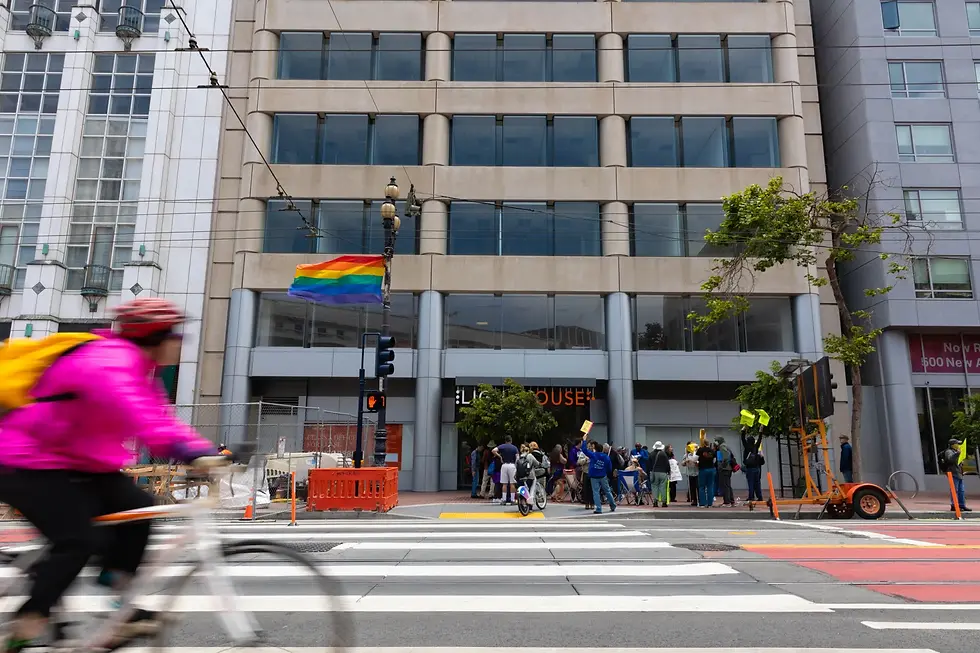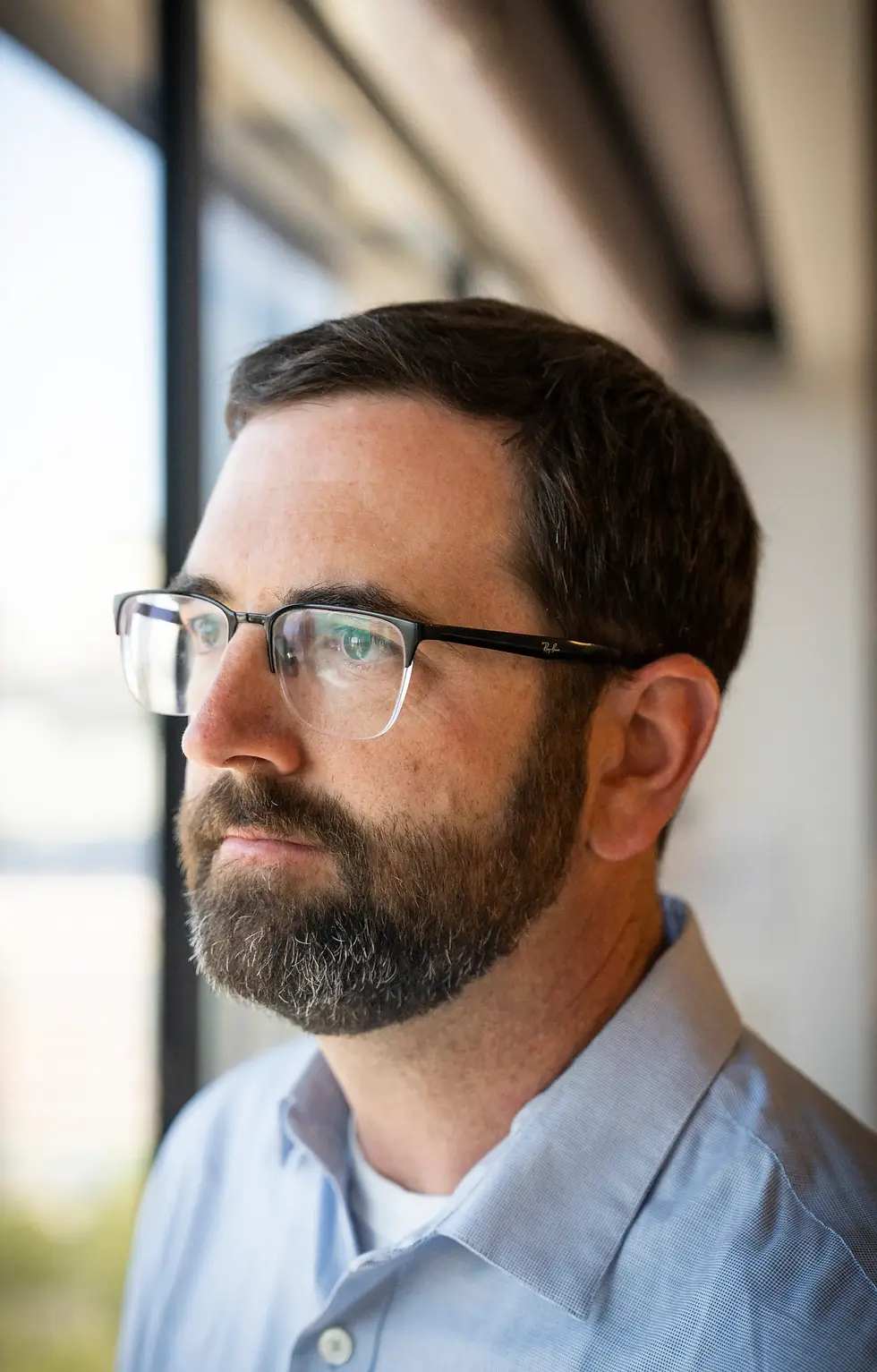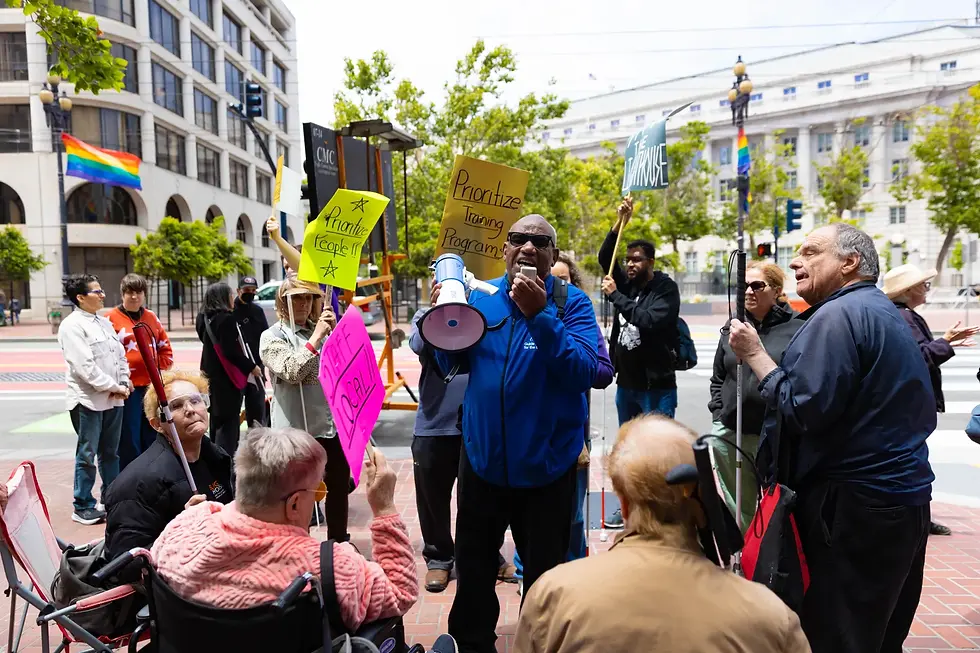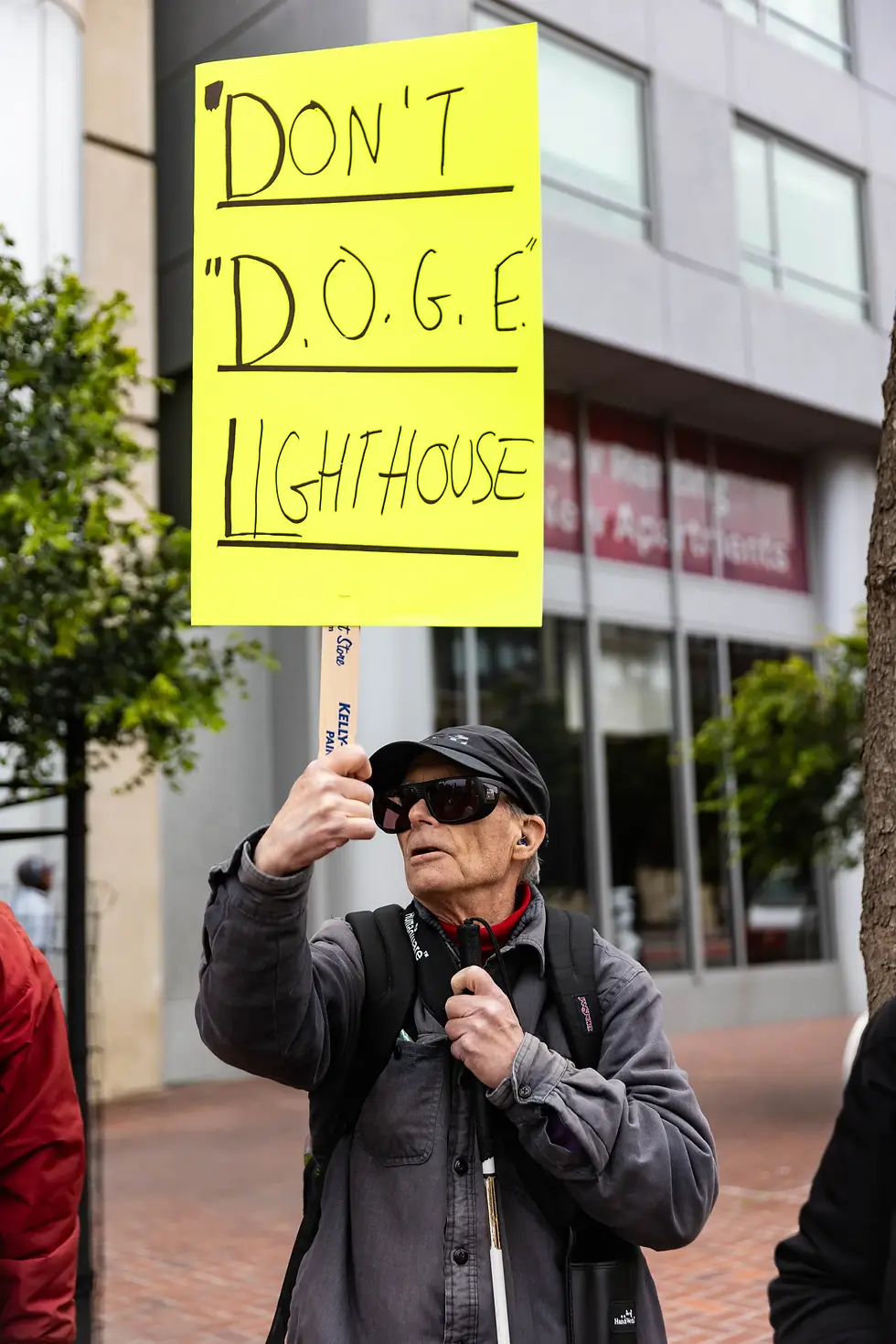Darkened dreams: How a nonprofit for the blind squandered a $125 million windfall
- Andrew Moore

- Jul 19
- 15 min read

A mysterious donation set LightHouse for the Blind and Visually Impaired on a new, hopeful course. Ten years later, everything has changed.
By Noah Baustin Published Jul. 17, 2025 • 6:00am
Bryan Bashin took over as CEO of LightHouse for the Blind and Visually Impaired in 2010. He envisioned something grander for the century-old nonprofit.
In his view, the organization was too narrowly focused on serving a small share of blind people in a small corner of California. He imagined a new kind of LightHouse, spreading a message of blind empowerment far beyond San Francisco. It was a confident sentiment that was contagious, as home-grown companies were going global and San Francisco was seen as the incubator for the future.
He just didn’t know how he’d pay for it.
Then, in 2014, Bashin received a mysterious email: $125 million was headed to LightHouse from Donald Sirkin, whom nobody at the organization had heard of.
It was, as far as Bashin knew, the largest single donation in the history of American blindness.

The money, left in Sirkin’s will, came with little explanation. But while visiting his late benefactor’s home in Washington state, Bashin reportedly spotted giant TVs, magnifiers, and light boxes — telltale gadgets of a man who had quietly lost his vision. Bashin could relate. Like many blind people, he hadn’t sought services for years as his vision was fading in adulthood.
The funds tripled LightHouse’s assets. The nonprofit began spending on a large scale, renovating its summer camp in Napa, expanding its programs by adding staff and managers, and acquiring a Mid-Market office building, placing it shoulder to shoulder with global tech giants in a neighborhood on the rise.
It newly saw itself as an organization that could improve the experiences of blind people worldwide, leveraging burgeoning relationships with its influential neighbors.
Nearly a decade on, the outlook is darker.
In the past 13 months, LightHouse’s lender seized eight floors of the Market Street property, nearly a third of the staff were laid off, and the organization shuttered an office in Eureka. Additional cuts loom.
Uber, Twitter, and the rest of the organization’s tech neighbors in Mid-Market are gone. While the nonprofit’s leaders are working to assure the blind community that LightHouse will survive, some worry that it could go next.
The Standard reviewed a decade of the nonprofit’s financial records, communications obtained through public records requests, and court filings. In interviews, more than a dozen current and former members of LightHouse’s staff and board of directors, several speaking on condition of anonymity for fear of reprisal, described the saga of an exceptional, mysterious gift amid an era of big techno-optimism that has not proved to be the savior everyone hoped. In the darkest moments, it has come to feel like a curse.
It’s a story that mirrors the boom and bust of San Francisco in recent years. The cash that flooded the city during the startup explosion of the 2010s was not enough to buoy it through the sharp downturn in 2020. Similarly, LightHouse’s optimism outstripped its resources: More money, more problems.
“I don’t know how many people who win the lotto say this,” said one former staffer, “but I think we worked better when we had no money.”
‘I can’t believe I work here’
The new headquarters was a centerpiece of Bashin’s vision. He was tired of blindness organizations with dilapidated facilities. LightHouse had occupied a century-old converted garage at 214 Van Ness Ave. since the 1990s. The workspace was gloomy and cramped, the furniture apparently antique. One staffer thought some desks were nearly as old as the nonprofit itself. Another recalled a manager keeping bottled water on hand for employees so they could avoid the cockroaches in the kitchen.
“We wanted more of the excitement of going into an Apple Store than going into a dopey social services organization,” Bashin said.
With LightHouse’s coffers bursting from the surprise donation, leadership decided to purchase an 11-story building at 1155 Market St. It was celebrated as a “savvy real estate play” — Mid-Market was booming, with new Uber, Twitter, and Spotify headquarters nearby. The organization would renovate and occupy the top three floors and continue renting out the lower eight to city departments.


Ahead of the grand opening in June 2016, David Chiu, at the time a member of the state Assembly, stood next to Bashin on the steps of City Hall.
“I think the sun is shining on the LightHouse today in San Francisco,” Chiu said. “You have been leading a revolution.”
When the headquarters opened, staffer Serena Olsen was blown away. The office was warm, welcoming, and — most significant to Olsen, who is blind — designed around the needs of visually impaired people. The rooms were equipped with electronic control boxes labeled in Braille. The floors were built with a type of concrete that made the sound of tapping canes more pleasing.
“I walked into that place every day and was like, ‘I can’t believe I work here,’” Olsen said. “It felt like an honor and privilege.”
The old furniture had been replaced by modern decor. Her favorites were the big, comfy womb chairs. Curling up in one “was just a big, purple hug.”
LightHouse was riding the high of the bequest.
“2016 is the year LightHouse embarked into a new era of blindness,” Bashin wrote in the organization’s annual report, “to change the global conversation about what it means to be blind in the 21st century.”
Money was going out the door quickly. The organization expanded its Alameda County operation and nearly doubled the number of class hours it offered across the Bay Area.
The staff grew 50% from 2015 to 2019, and total annual employee compensation more than doubled.
After LightHouse’s Enchanted Hills summer camp in Napa County burned down in the 2017 Wine Country fires, the organization’s leaders decided to expand and improve the facility, a project that would ultimately cost $55 million.



And, just as Bashin had dreamed, the organization was increasingly making its mark beyond the Bay. In 2019, LightHouse students, including those staying at the Enchanted Hills Camp and Mid-Market headquarters, hailed from 45 of California’s 58 counties.
The organization’s marquee Holman Prize reached even farther, giving out awards of up to $25,000 to people with vision impairments from around the globe who wanted to embark on adventures that could change perceptions of blind people’s capabilities.
Further expanding LightHouse’s influence was its work consulting on tech accessibility with Google, Microsoft, and Salesforce.
But for all the high-profile success and rapid expansion, some staffers felt the nonprofit had lost touch with its core goals.
“We weren’t just the LightHouse for the Blind for the San Francisco Bay Area; I felt like we were going to this space where we had to be the LightHouse for the Blind for the world,” one former staffer said. “I think there’s a space you get into where you have so much [money] that, all of a sudden, you just feel that power, and you need to demonstrate that power.”
For an organization that relied on providing in-person experience, Covid presented an existential threat.
Documented teaching hours — and income — at LightHouse dropped. LightHouse logged an operational deficit in 2020.
But that didn’t stop the spending. That year, leaders announced plans to make Enchanted Hills Camp a “global center for blindness training.” The final price: $55 million. In 2021, the nonprofit moved and upgraded industrial facilities where it employed visually impaired people to make toilet paper and cleaning products. That cost $10 million.
In 2021, the operational deficit hit $11.2 million. Meanwhile, Bashin’s annual compensation had been steadily growing. It more than doubled between 2015 and 2022, peaking at more than $413,000.
In early 2022, Bashin notified the board of directors that he wanted to step down. Plans were in the works for his phase-out.
Bashin had led LightHouse through a wholescale reinvention and was hailed publicly as a visionary. But within the organization, he had earned a different reputation.
In 2022, an employee complaint about Bashin spurred LightHouse to tap the human resources firm ADP to conduct an investigation. Nine employees said both Bashin and Brandon Cox, the organization’s COO at the time, belittled and ignored women and created a misogynistic workplace environment, ADP reported that August.
Cox said that in the wake of the investigation, he sent an apologetic message to the staff.
After 12 years at the helm, Bashin departed in September 2022.
‘Blindsided in the shadows of City Hall’
By 2023, the staff had returned to working in the office, and LightHouse was hosting community events once more. A new CEO, Sharon Giovinazzo, had taken over.
But the optimism ushered in by the bequest had evaporated. After the upheaval in leadership, LightHouse workers became embroiled in a contentious unionization effort. And San Francisco had changed, too.
Businesses, along with workers and residents, fled Mid-Market. Across the street from the LightHouse headquarters, United Nations Plaza had become the epicenter of the overdose crisis. According to a former staffer, blind people arriving at LightHouse for training and services would sometimes have needles stuck in their shoes.
LightHouse had bought its building when real estate was surging. In 2023, values were plunging. Office buildings were selling for deep discounts. When the lease renewal for the city offices downstairs went before the Board of Supervisors, the legislators thought LightHouse was asking for too much.


“I just think we need to send a message not only to this property owner but to the plethora of property owners that do business with the city and county of San Francisco,” said Aaron Peskin, then president of the Board of Supervisors.
On Sept. 26, 2023, the board voted unanimously to turn down the deal.
Cox was floored to see the city turn its back on LightHouse.
“We are a blindness nonprofit. We are not developers,” Cox said.
In March 2024, Giovinazzo emailed Mayor London Breed under the subject line “Blindsided in the shadows of City Hall.”
“The failure of the city to engage in constructive dialogue with the LightHouse for the Blind is deeply troubling,” she wrote. “I urge you to consider the broader implications of [these] lease negotiations.”

The city departments began moving out two months later. LightHouse couldn’t find a tenant to replace them.
Though LightHouse owned the whole building, the bottom eight floors of the Mid-Market building were held in an entity separate from the top three, where LightHouse had its headquarters. The city’s pullout set into motion a default on the bottom eight floors. In June 2024, the lender’s trustee sued to foreclose on the property.
In one fell swoop, LightHouse lost its keystone real estate investment. Between the neighborhood’s decline and the default, the value of the remaining three floors had plummeted. In 2024, the organization logged a $23 million loss of value on its remaining headquarters, based on an appraisal.
The financial slide was gaining momentum.

In its May 2024 audit, Hood & Strong found a “significant deficiency” in the internal controls LightHouse’s finance department was using to ensure accurate reporting. The auditor concluded that LightHouse’s CFO and controller “do not have sufficient resources to allow timely and accurate financial reporting.”
The organization’s $5.4 million operational deficit during the 2022 fiscal year had jumped to $16.9 million in 2023. In 2024, operating expenses climbed 13%, driven by a $4.4 million increase in personnel costs. A spokesperson said that during this time, LightHouse leaders did not see timely department-level financial reports for more than a year due to problems with an accounting system.
Nonetheless, leadership remained bullish on the organization’s finances, with new growth plans in the works. LightHouse was in the midst of taking over the struggling Earle Baum Center of the Blind in Sonoma County.
One former staffer said Giovinazzo and Cox discouraged workers from questioning whether there was enough funding to support these outlays.
“We were told that was a negative thought,” the former staffer said.
In July 2024, Keith Edwards joined as the new CFO. There was a quick shift from expansion to cost-cutting.
Layoffs began, and 11 employees had lost their jobs by year’s end.
LightHouse ended 2024 with major losses. Its investment holdings dropped $44 million in one year.
‘The cruelest thing’
An hour and a half from San Francisco, the LightHouse acquisition in Sonoma County is spread across 17 acres dotted with oaks and scented with lavender. Upon his death, Earle Baum, a blind farmer, had left the land for a community center for people with visual impairments. In 2000, the inaugural CEO of the Earle Baum Center hired its first employee: a blind recreational therapist who loved tap dancing, cross-country skiing, and travel. Her name was Denise Vancil.
Together, they built the organization Baum had envisioned. Vancil developed curricula for classes on how to cope with vision loss and read Braille. She founded a tap dance group.
Vancil’s working headquarters was a two-bedroom home that became known at Earle Baum as “Denise’s house.” In her home away from home, Vancil could educate visitors on the day-to-day tasks that become challenging as vision fades.
She taught techniques for safely cutting vegetables, pouring hot coffee, and cooking on a gas range. At the end of a 12-week session, Vancil and her students would prepare a feast and celebrate.
“You were coming into a home, sitting in a living room, having a talk with someone else who couldn’t see,” Vancil said. “People just felt so much happier that they were living their lives again.”
The Earle Baum Center served many students who were unable to pay, aiming to make up the difference with grant funding and donations. But by the 2020s, the nonprofit’s finances were in dire shape. In 2023, LightHouse agreed to absorb the center. To Vancil, LightHouse was “our rich cousin.” Earle Baum was saved, she thought.
Less than a year after LightHouse took over, in April 2025, Vancil received an email. After 25 years of service, she was being laid off.
“I was shocked that they would let go of someone who’s blind who could serve as a motivator, someone who’s blind who can speak to the LightHouse mission of uplifting and employing the blind,” Vancil said.
At the San Francisco headquarters, other employees were getting the same bad news.
Cox had taken over as interim CEO just a few months prior. He was working from home the day that staffers impacted by the layoff lost access to their keycards and computers.
“It was the cruelest thing I think I’ve ever seen,” said one staffer who was let go.
As the news spread, it spurred outrage across the Bay Area blind community. Perhaps the most wounding fact was that LightHouse leadership, mostly sighted executives, had let go multiple staffers with vision impairment. The California Council of the Blind passed a resolution calling for Cox’s ouster.
All told, 40 employees lost their jobs in the first months of 2025, including some who had been serving the blind community for decades. In June, the wait for core blindness skills training could be up to three months. People looking to buy canes and other tools could no longer walk into LightHouse headquarters to shop. Its Adaptions Store was closed, pending a permanent move online.
“We’re an emaciated organization,” staffer Frank Welte told the LightHouse board.
From the end of 2024 through May, the organization’s investments shrunk another $13 million, as the nonprofit dipped further into reserves to cover ongoing operating losses, according to a LightHouse spokesperson. That left it with $82 million, or about two-thirds of the life-changing bequest. That $82 million war chest would have sustained the old LightHouse, which had about $5.6 million in expenses in 2014. But the new LightHouse had expenses in 2024 of $31.3 million and had just come off two straight years of nearly $17 million operational deficits.
“If you don’t change course, you’re out of funds within a 10- or five-year period of time,” said Cox.



Many saw the layoffs as an indication that LightHouse’s ambitions, fueled by that mysterious 2015 windfall, had gone too far. By spending fast and loose on real estate, renovations, and swelling bureaucracy, the organization had put itself in peril, and its core missions of training and building the blind community were suffering.
In Cox’s view, rightsizing LightHouse is exactly what will keep it serving the community. “We must bring the organization to a point of sustainability,” he said. “We’re still very hopeful for this organization; we want it to last another 120 years.”
Another round of layoffs was scheduled for July, but leaders have committed to reviewing the fall financials first. In the meantime, the C-suite took a 15% pay cut, while vice presidents’ salaries dropped 10%, according to Cox.
The spectre of layoffs isn’t the only shadow over LightHouse.
The San Francisco Office of Labor Standards Enforcement has an active investigation into LightHouse for a Health Care Security Ordinance audit, while a complaint alleging the nonprofit misused grant money is pending before the Federal Communications Commission.
The nonprofit still has significantly more assets than it did before the 2015 windfall. But Cox’s biggest challenges might be convincing the Bay Area blind community that LightHouse will survive and winning back their trust. For some, Cox is representative of a shift away from hands-on organization to bureaucratic behemoth.
Cox has heard that criticism. Back in the pre-bequest days, “it was kind of more of a homier, community feel,” he said. But the new LightHouse shines far beyond San Francisco.
“It’s just a different feel,” he said.
‘What happened to the money?’
When the LightHouse headquarters opened in 2016, 1,000 people marched down Market Street chanting “Blind and proud.” Laura Millar marched with them, but she thought it all “sounded a little nuts.”
She had been blind for 13 years, and the situation had not inspired her in the least. She struggled to complete daily tasks. She didn’t have blind friends. But she was suddenly among her people.
A few weeks later, Millar joined LightHouse’s staff as part of its rapid expansion. She learned new skills and forged friendships.
It “changed my opinion and my outlook on blindness completely. Blindness wasn’t the end of the world,” she said. “And I got all that working at LightHouse.”
Nine years after the ribbon-cutting that set her life on a new course, Millar stood in front of LightHouse’s Mid-Market office. This time not to celebrate, but to protest. It was the first of two protests against LightHouse leaders in June. The crowd was much smaller than it had been in 2016 — just a few dozen but no less passionate. They chanted, “What happened to the money?”
“I stand here now blind and proud,” Millar said, “but afraid that we’re going to lose it in three years if we don’t do something.”
Now retired, protester Tricia Leetz spent 20 years as a vocational counselor for people losing their vision. She frequently referred clients to LightHouse so they could learn how to use a cane, shop, cook, and use technology. She fears that the layoffs will reduce access to necessary training.
Leetz is legally blind but has about 8% of her vision. “If I lose more, I wouldn’t have this resource to come to,” Leetz said. “I always knew in my head that I’d have this place to help me if I needed it.”
The crowd booed and jeered at the soaring facade of the nonprofit’s headquarters. Once a bright promise of the commitment to guide the world to seeing blind people anew, the building now appears to be anything but a lighthouse. The dark windows of the empty lower floors appear symbolic of the end of what Bashin had hoped would be a new era for blind people across the globe.
“Money has been squandered,” Leetz said. “Did everything have to be so fancy?”
Noah Baustin can be reached at nbaustin@sfstandard.com




Comments